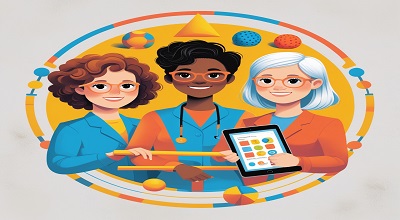Occupational Therapy Collaboration
Occupational Therapy Collaboration: Occupational therapy (OT) is a client-centered healthcare profession that helps individuals achieve independence in all aspects of their lives. Collaboration is a crucial aspect of occupational therapy, as it involves working with other professionals, patients, and families to ensure the best outcomes.
In this blog post, we will explore the importance of occupational therapy collaborations, different types of collaboration, real-world examples, and the latest trends in the field.
What is Occupational Therapy Collaboration?
Occupational therapy collaborations refer to the process where occupational therapists (OTs) work alongside other healthcare professionals, educators, caregivers, and patients to develop and implement effective treatment plans.
This teamwork ensures a holistic approach to patient care, addressing physical, emotional, and social needs.
Why is Collaboration Important in Occupational Therapy?
Collaboration enhances the effectiveness of occupational therapy by:
- Providing comprehensive care
- Improving patient outcomes
- Reducing treatment gaps
- Enhancing communication among professionals
- Encouraging patient engagement
Without collaboration, treatment plans may lack continuity, leading to suboptimal results.
Types of Occupational Therapy Collaborations
A. Interprofessional Collaboration
This involves OTs working with professionals from different fields, such as:
- Physicians
- Physical therapists
- Speech therapists
- Social workers
Example: A stroke rehabilitation team may include an OT, neurologist, and physiotherapist to improve motor skills and daily living activities.
B. Intraprofessional Collaboration
Here, OTs collaborate with other occupational therapists or OT assistants to share knowledge and refine treatment strategies.
C. Patient-Centered Collaboration
OTs work directly with patients and their families to set personalized goals and interventions.
D. Community-Based Collaboration
OTs partner with community organizations, schools, and workplaces to promote accessibility and inclusion.
Examples of Occupational Therapy Collaborations
A. Schools & Educational Settings
OTs collaborate with teachers and special educators to support children with disabilities.
- Example: An OT helps a child with autism improve handwriting skills while working with the teacher to modify classroom activities.
B. Hospitals & Rehabilitation Centers
OTs work with surgeons, nurses, and physiotherapists to help patients regain independence post-surgery or injury.
C. Mental Health Facilities
Collaboration with psychologists and psychiatrists helps patients with mental health conditions develop coping strategies.
D. Geriatric Care & Nursing Homes
OTs assist elderly patients with mobility and daily tasks while coordinating with caregivers and doctors.
E. Workplace & Ergonomics
OTs collaborate with employers to design ergonomic workspaces, reducing injuries and improving productivity.
Latest Trends in Occupational Therapy Collaborations
A. Telehealth & Virtual Collaboration
Remote OT sessions via video calls allow therapists to collaborate with patients and professionals worldwide.
B. AI & Technology in OT
Wearable devices and AI-driven tools help monitor patient progress and adjust treatment plans in real time.
C. Evidence-Based Collaborative Practices
Research-driven approaches ensure that collaboration strategies are scientifically validated for better outcomes.
Challenges in Occupational Therapy Collaborations
- Communication barriers between professionals
- Differences in treatment philosophies
- Limited resources in some settings
- Patient non-compliance
How to Improve Collaboration in Occupational Therapy?
- Regular team meetings
- Clear communication protocols
- Continuing education on collaborative practices
- Patient and family involvement in decision-making
Conclusion
Occupational therapy collaboration is essential for delivering high-quality, patient-centered care. By working with other professionals, OTs can enhance treatment effectiveness and improve patient independence. The latest trends, such as telehealth and AI, are revolutionizing collaboration in OT, making it more efficient and accessible.
